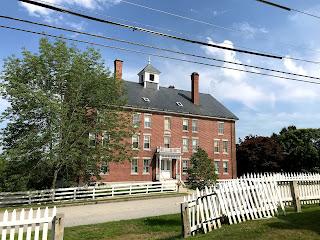The religious sect began in Manchester, England, in the early 1700's. It was formally United Society of Believers in Christ's Second Appearing; "Shaker" came from "Shaking Quaker" because of the religious dancing during worship. Founder Ann Lee (known as "Mother Ann") and eight followers emigrated to the colonies in 1774. They practiced gender equality and celibacy. They grew through conversion and, later, by adopting orphans. They were pacifists and successful entrepreneurs -- the seed and herb industries began in the 1780's. They made furniture and household accessories (baskets, boxes). They invented the squared-off broom. Their hymns are well-known (especially "Simple Gifts").
[Wikipedia has this summary.]
At their peak there were 5000 Shakers in 19 societies from Maine to Kentucky. Now there are two Shakers who live at Sabbathday Lake, Maine. The Shaker properties are individually owned and maintained by non-profit trusts
We visited three Shaker villages on this trip. What a treat! We'd been to two of them years ago; another was new for us. (Our 1999 Road Scholar trip was to the Shaker Village at Pleasant Hill, Kentucky, with a side trip to see the remaining Shaker dwelling at South Union, Kentucky.)
Saturday, July 21: Canterbury, New Hampshire (with daughter Julie and granddaughter Alyssa). Canterbury was active from 1792-1962. The remaining sisters voted to close enrollment thinking that converts would not interpret and practice the faith as they thought it should be. They opened the site to tourists and, until the last sister died in 1969, they conducted the tours. We were there during arts week with performers (dance, music) and artists (sculptor, potter).




The early 20th century Canterbury Shakers installed an organ in their meetinghouse. They had an orchestra
Saturday, July 28: Sabbathday Lake, Maine
The community was established in 1782. The last two Shakers in the world live here. (We did not see them). The tour was something of a disappointment. Only two buildings (and the visitor's center/shop) were open. Interior photography was not allowed.
The meeting house has the original (1794) interior paint.

Sunday, July 29: Hancock Shaker Village, Massachusetts
As we were planning our post-Magpie route home I realized that we'd go right past Hancock. GPS told us it was only 284 miles from Poland Spring. (Ah, the compact-ness of New England.) Despite traffic congestion from southern Maine to Worcester we made it to Hancock at 2 p.m. There was a chair in the shade where Stevens sat while I roamed the grounds. Founded in the 1780's, Hancock was the largest Shaker community (300 at its peak). It was the first to become a museum, in 1960, and it is well-planned to accommodate tourists. There are 20 authentic buildings. It's also an active farm.
The round stone barn is the most distinctive building at Hancock. Why did they build it? "Because they could," said the guide. It was an efficient way to feed and milk the cows.
A few more Shaker photos:












Sounds like you had an overall interesting trip. I have always been interested in the ingenuity of the Shakers. That round stone barn was my favorite thing at Hancock.
ReplyDeleteL looked at the photo of the round barn and immediately thought of the round stables in Buxton It had a roof added over the exercise yard later and was at one point the largest unsupported dome in the world.
ReplyDelete